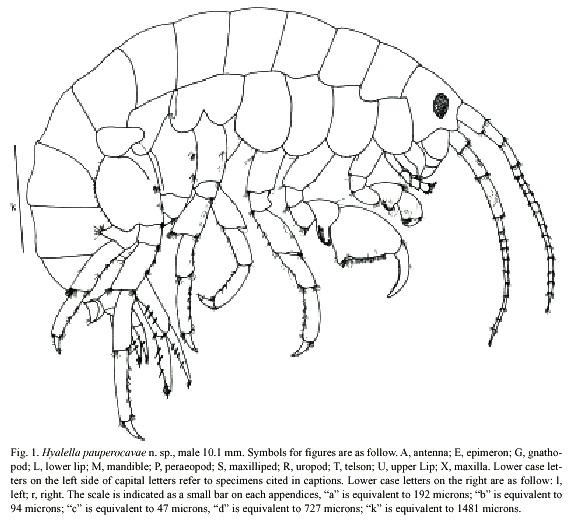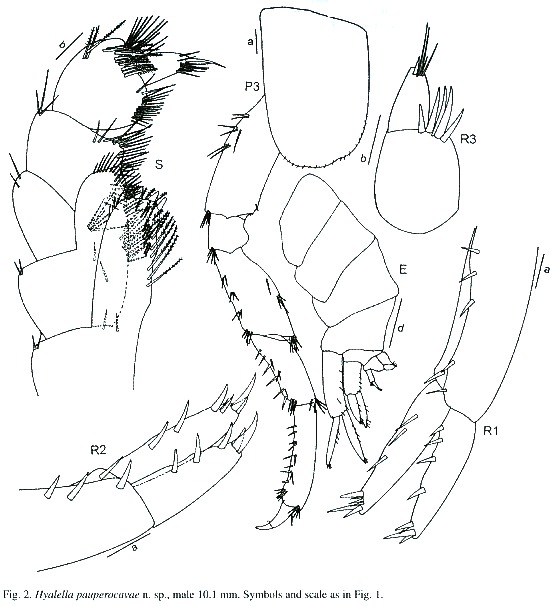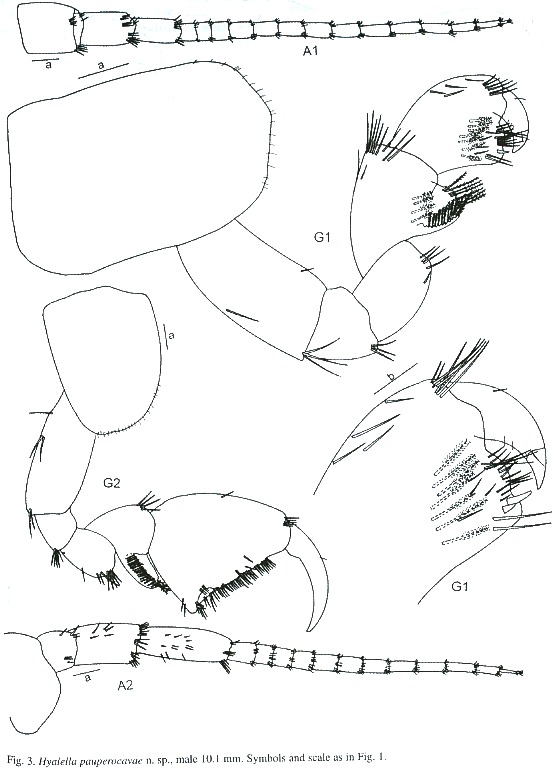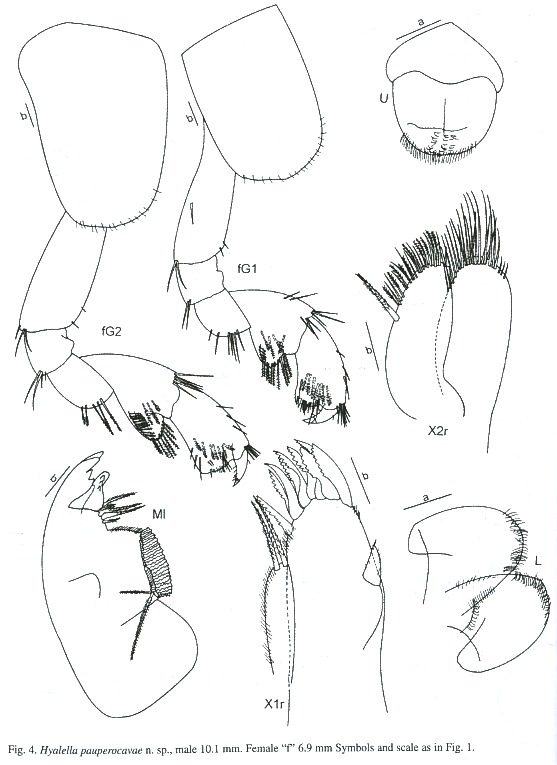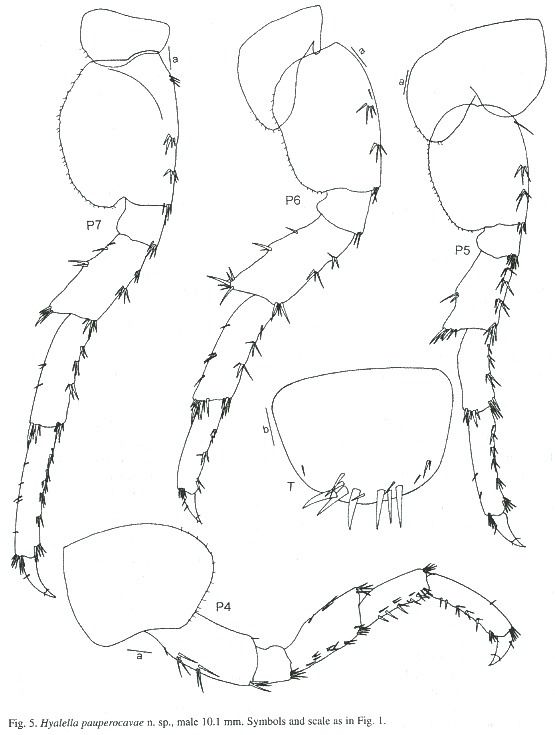Services on Demand
Journal
Article
Indicators
-
 Cited by SciELO
Cited by SciELO -
 Access statistics
Access statistics
Related links
-
 Similars in
SciELO
Similars in
SciELO  uBio
uBio
Share
Revista de Biología Tropical
On-line version ISSN 0034-7744Print version ISSN 0034-7744
Rev. biol. trop vol.50 n.2 San José Jun. 2002
(Crustacea: Amphipoda: Hyalellidae)
Exequiel R. González 1 and Les Watling 2
1 Facultad de Ciencias del Mar, Universidad Católica del Norte, Casilla 117, Coquimbo, Chile, Ph.: 56-51-209931, Fax 56-51-209812, e-mail: egonzale@ucn.cl
2 Darling Marine Center, University of Maine, 193 Clarks Cove Rd., Walpole, Maine 04573, USA, Ph.: 207-563-3146, Fax 207-563-8407, e-mail: watling@maine.edu
Received 20-VII-2001. Corrected 07-V-2002. Accepted 24-V-2002.
Abstract
Hyalella pauperocavae n. sp. from Huancayo, Perú, is described. Five other epigean freshwater amphipods have been described from Peru (excluding Lake Titicaca), but the lack of type material and poor descriptions do not allow the assignment of the species described here to any of the names known for the area.
Key words: Freshwater, Amphipoda, Hyalellidae, epigean, Perú.
Five species of epigean freshwater amphipods have been recorded from Perú: Hyalella jelskii (Wrzesniowski 1879) in the Cordillera of Pumamarca (14° 02 S, 76° 16 W), H. lubomirskii (Wrzesniowski 1879) in Pacasmayo (7° 25 S, 79° 34 W), H. dybowskii (Wrzesniowski 1879) in Paucal, Montaña Nacho (7° 00 S, 79° 08 W), H. simplex cangallensis Schellenberg, 1943 in Pampa de Cangallo (13° 25 S, 74° 20 W) and Laguna Urcos, Cuzco (13° 41 S, 71° 37 W), and H. meinerti Stebbing, 1899 in Rio Apurimac (14° 00 S, 73° 00 W). The first three species were described as Hyale by Wrzesniowski (1879). Schellenberg (1943) also described H. pteropus, which is now in the synonymy of H. meinerti Stebbing, 1899 (González and Watling 2002a). Unfortunately all the above species are poorly described. Wrzesniowski (1879) did not include figures in his descriptions, and type material is not available.
A few other species have been recorded from the Peruvian side of Lake Titicaca (Faxon 1876, Chevreux 1907, and Weckel 1910); we will not discuss them here. They are the subject of a work soon to be published elsewhere.
Here we describe H. pauperocavae n. sp. from Huancayo (12° 03 S, 75° 07 W) in central Perú, east of Lima, and we also extend the distributional range of H. kochi González and Watling, 2001 to Perú.
Material and methods
Collections were made in a small creek at the Trout culture station "El Ingenio", Huancayo, Perú, at 3 425 m high, among algae and in muddy substrate.
The morphological characters were coded and descriptions generated using the taxonomic database DELTA (Dallwitz et al. 1999). The terminology for setae follows Watling (1989) and Oshel and Steele (1988). Measurements of the specimens were made from the tip of the head to the base of the telson. This convention was chosen because of the variable position of the tip of the telson in different specimens. The computer program Image-Pro Plus (Media Cybernetics 1997) was used to measure the specimens. Latitude and longitude were determined from a gazetteer. Localities whose record indicates a wide region, were assigned to a middle point of that region.
Results
Hyalella pauperocavae n. sp. Figs. 1-5
Type Material: Holotype, adult male 8.4 mm. Nov. 23, 1997, Trout culture station "El Ingenio", Huancayo, Perú (12°03 S, 75°07 W). United States National Museum, USA, (USNM, N°1001224). Paratypes, 2 males and 2 females, Nov. 23, 1997, Trout culture station "El Ingenio", Huancayo, Perú. United States National Museum, USA (USNM, N°1001226). D. Ore Jr., coll.
Type locality: Huancayo, Perú.
Material examined: Huancayo, Perú.
Diagnosis: Body surface smooth. Coxa 4 slightly excavated posteriorly. Eyes pigmented. Antenna 1 subequal in size to antenna 2. Antenna 2 less than half body length. Mandible incisor toothed. Maxilla 1 palp longer than wide, reaching to less than half the distance between base of palp and tip of setae on outer plate; inner plate slender, with two strong and pappose apical setae. Maxilla 2 inner plate with one strong pappose seta on inner margin. Gnathopod 1 propodus length less than two times maximum width (quadrangular), hammer shape, inner face with ten pappose setae, disto-posterior and disto-anterior borders without setose scales. Gnathopod 2 propodus triangular, palm longer than posterior margin, slope oblique, anterior edge smooth. Peraeopods 3 and 4 merus and carpus posterior margin with three to four hind marginal clusters of short setae; propodus posterior margin with five to eight groups of setae. Uropod 3 peduncle with five strong distal setae; outer ramus shorter than peduncle, basal width two times or less tip of ramus. Telson wider than long, apically rounded, with more than two strong setae, asymmetrically distributed on apical margin. Sternal gills on segments 3 to 7. Female. Gnathopod 1 similar in size, and same shape to gnathopod 2. Gnathopod 2 different from male gnathopod 2 in shape and smaller, propodus length less than two times maximum width, normally sub-chelate, palm transverse.
Description of male: Size 10.1 mm. Body surface smooth (Fig. 1). Epimeral plate 1 round, 2 and 3 straight (Fig. 2 E). Coxae 1 to 4 subequal in size and shape, slightly overlapping. Acumination in coxae absent. Coxa 1 same as 2 and 3. Coxa 3 same width as 4. Coxa 4 deeper than wide, slightly excavated posteriorly. Coxa 5 posterior lobe deeper than anterior. Coxa 6 anterior lobe small.
Head smaller than first two thoracic segments, typically gammaridean, rostrum absent. Eyes pigmented, medium, slightly reniform, located behind insertion of antenna 1.
Antenna 1 less than half of body length, subequal in size to antenna 2, much longer than peduncle of antenna 2; peduncle longer than head, articles 1 and 2 subequal in length, article 3 same as article 1 and 2 in length; flagellum of 14 articles, longer than peduncle, basal article not elongated; asthetascs on flagellum, from articles 3 to distal end (Fig. 3 A1).
Antenna 2 less than half body length; peduncle slender, longer than head, article 4 shorter than article 5, setal groups on article 4 and 5 abundant; flagellum of 13 articles, longer than article 5, basal article not elongated (Fig. 3 A2).
Basic amphipodan mandible (sensu Watling, 1993), but without palp; incisor toothed; left lacinia mobilis with four teeth; setae row on left mandible with three main setae plus two accessory setae, right mandible with two main setae plus accessory setae; molar large, cylindrical, and triturative, accessory seta present. Labrum ventral margin round. Lower lip outer lobes rounded without notches or excavations, mandibular projection of outer lobes round (Fig. 4 Ml, L, U).
Maxilla 1 palp uniarticulate, longer than wide, reaching to less than half the distance between base of palp and tip of setae on outer plate, distal setae feeble; inner plate slender, smaller than outer plate, with two strong and pappose apical setae; outer plate with nine stout and serrate setae (Fig. 4 X1r). Maxilla 2 inner plate subequal in length and width to outer plate, one strong pappose seta on inner margin, outer and inner plates with scarce setules (Fig. 4 X2r).
Maxilliped inner plates apically truncated, with three connate setae, pappose setae apically and medially; outer plates larger than inner plates, apically truncated, apical, medial and facial setae simple; palp longer than outer plate, four articles; article 2 wider than long, medial margin with long simple setae; article 3 outer distal face with several long simple setae, inner distal face with long plumose setae, inner distal margin with long setae, outer margin with one or two strong, and long plumose setae; dactylus unguiform, shorter than third article, distal setae simple and shorter than nail, inner border without setae, distal nail present (Fig. 2 S).
Gnathopod 1 subchelate; carpus longer than wide, subequal in length, and wider than propodus, with strong and wide posterior lobe, produced and forming a scoop like structure, open to the inside, inner face with four to seven pappose setae, border pectinate and with several pappose setae; propodus length less than two times maximum width (quadrangular), hammer shape, with four setae on anterior border, inner face with ten pappose setae, without small triangular setae, disto-posterior and disto-anterior borders without setose scales, palm slope transverse, margin convex, posterior distal corner with robust setae; dactylus claw-like, with one to three endal setae, congruent with palm (Fig. 3 G1).
Gnathopod 2 subchelate; basis hind margin with one to three groups of setae; merus with seven or more setae on posterior margin, postero-distal margin rounded, distal corner rounded; carpus posterior lobe elongated, produced between merus and propodus, border pectinate with several pappose setae; propodus triangular, disto-posterior and disto-anterior borders without setose scales, palm longer than posterior margin, slope oblique, margin straight, several medium size setae, anterior edge smooth, posterior distal corner with strong setae, and with cup for dactyl; dactylus claw-like, congruent with palm, with several endal setae (Fig. 3 G2).
Peraeopods 3 to 7 simple. Peraeopods 3 and 4 merus and carpus posterior margin with three to four hind marginal clusters of short setae; propodus posterior margin five to eight groups of setae; dactylus less than half-length of propodus. Peraeopods 5 to 7 all similar in structure and slightly longer successively; dactylus less than half-length of propodus. Peraeopod 5 subequal to peraeopod 4, basis posterior lobe deeper than wide, smaller than posterior lobe of peraeopod 7, merus with one hind marginal setae. Peraeopod 6 longer than peraeopod 4, basis posterior lobe deeper than wide, similar to posterior lobe of peraeopod 5, and smaller than posterior lobe of peraeopod 7. Peraeopod 7 subequal to peraeopod 6, basis posterior lobe deeper than wide (Fig. 2 P3; Fig. 5 P4, P5, P6, P7).
Pleopods not modified; peduncle slender; longest ramus longer than peduncle.
Uropod 1 longer than uropod 2; peduncle longer than rami; rami subequal; inner ramus with three dorsal and six distal setae, only one longer, male without curved setae on inner side of the ramus; outer ramus with four dorsal and four distal setae; peduncle setation present (Fig. 2 R1).
Uropod 2 outer ramus shortened; inner ramus with two dorsal and five distal setae; outer ramus with two dorsal and three distal setae; peduncle setation present (Fig. 2 R2).
Uropod 3 longer than urosomite 3, shorter than peduncle of uropod 1, shorter than peduncle of uropod 2; peduncle globose, wider than ramus, with five strong distal and no marginal setae; inner ramus absent; outer ramus uniarticulate, shorter than peduncle, basal width two times or less tip of ramus, with four simple apical slender setae, and one connate seta (Fig. 2 R3).
Telson wider than long, entire, apically rounded, with more than two strong setae (six to eight), asymmetrically distributed on apical margin (Fig. 5 T).
Coxal gills saclike, on segments 2 to 6. Sternal gills tubular, on segments 3 to 7.
Characters of female that differ from male: Size, 6.9 mm. Antenna 1 and 2 flagellum with ten articles. Gnathopod 1 similar in size, and same shape as gnathopod 2; similar to male gnathopod 1 in size and shape. Gnathopod 2 different from male gnathopod 2 in shape and size (smaller), propodus length less than two times maximum width, normally subchelate, palm transverse (Fig. 4 fG1, fG2).
Habitat: Freshwater, epigean, littoral.
Distribution: Huancayo, Perú. 3 500 m.a.s.l., Perú, South America.
Etymology: The specific epithet comes from the Latin paupero meaning poorly, and cavae meaning excavation, in reference to the poorly excavated posterior border of coxa 4.
Discussion
General remarks: The five species of Hyalella previously recorded for Perú have been described briefly and some of the original descriptions even lack figures. From those descriptions we conclude that none of them correspond to the new species described here. The type specimens or any other type series for those species are lost. H. pauperocavae has two very distinct characters, unique among the species in the genus. Antenna 1 is similar in length to antenna 2, and coxa 4 has a wider and shallower posterior excavation. It has also sternal gills on segments 3 to 7. None of these characters agree with those mentioned in the known species. H. dybowskii has sternal gills on segments 3 to 7, however, the size of the antennae do not match with the ones from H. pauperocavae. The other two species described by Wrzesniowski (1879) have sternal gills on segments 2 to 7 or 2 to 5.
The few morphological characteristics of H. simplex cangallensis given in Schellenberg (1943) are not enough to assign it to any known species. The unavailability of type specimens or any type series makes the decision more difficult. The telson and gnathopod 2 of H. simplex cangallensis are similar to H. pauperocavae, however, the unique characteristics given above for H. pauperocavae are not mentioned by Schellenberg (1943). Bousfield (1996) recorded Schellenbergs species as H. cangallensis. The data available are not sufficient to suggest that it is a synonym of H. pauperocavae.
Bousfield (1996) also recorded for Perú H. simplex described by Schellenberg (1943) in replacement of H. knickerbockeri (Bate, 1862) in Schellenberg (1931), now restricted only to the material from Punta Arenas, Chile (González and Watling 2002b).
Hyalella kochi González and Watling, 2001 known previously only from the Andes in Chile (18° 32 S, 69° 11 W to 24° 35 S, 69° 00 W), lives sympatrically with H. pauperocavae. This record extends its distributional range to the Andes in Perú (12° 03 S, 75° 07 W).
Acknowledgments
We thank Daniel Ore and Daniel Ore Jr. who collected the material of Hyalella from Perú. This work was largely funded by Universidad Católica del Norte, Chile and University of Maine, USA. A grant from the National Science Foundation, PEET (Partnership for Enhancing Expertise in Taxonomy) program to Les Watling also provided partial funding.
Resumen
Se describe la especie Hyalella pauperocavae n. sp. recolectada en la localidad de Huancayo, Perú. Otras cinco especies de anfípodos epígeos se conocen para el Perú (excluyendo aquellas presentes en el Lago Titicaca). La ausencia de material tipo y descripciones poco claras impidieron la asignación de la especie descrita aquí a alguno de los nombres conocidos para el área.
References
Bate, C.S. 1862. Catalogue of the specimens of Amphipodous Crustacea in the collection of the British Museum. Br. Mus. (Natural History) London, 399 p. [ Links ]
Bousfield, E.L. 1996. A contribution to the reclassification of Neotropical freshwater hyalellid amphipods (Crustacea: Gammaridea, Talitroidea). Boll. Mus. civ. St. nat. Verona 20: 175-224. [ Links ]
Chevreux, E. 1907. Les amphipods des lacs des hauts pla-teux de lAmerique du Sud. Mission Scientifique G. de Crequi-Monfort et Senegal de la Grange, Lacs Hauts Plateuaux de lAmerique du Sud. 22 p. [ Links ]
Dallwitz, M.J., T.A. Paine & E.J. Zurcher. 1999. Users Guide to the DELTA System. A General System for Processing Taxonomic Descriptions. Edition 4.10. Division of Entomology, CSIRO, Australia. 168 p. [ Links ]
Faxon, W. 1876. Exploration of Lake Titicaca by Alexander Agassiz and S.W. Garman. IV. Crustacea. Bull. Mus. Comp. Zool. 3: 361-375. [ Links ]
González, E.R. & L. Watling. 2001. Three new species of Hyalella from Chile (Crustacea: Amphipoda: Hyalellidae). Hydrobiologia 464: 175-199. [ Links ]
González, E.R. & L. Watling. 2002a. A new species of Hyalella from Colombia, and the redescription of H. meinerti Stebbing, 1899 from Venezuela (Crustacea: Amphipoda). J. Nat. Hist. (in press). [ Links ]
González, E.R. & L. Watling. 2002b. A new species of Hyalella from the Patagonia, Chile, with redescription of H. simplex Schellenberg, 1943 (Crustacea: Amphipoda). J. Nat. Hist. (in press). [ Links ]
Media Cybernetics, L. P. 1997. Image-Pro Plus for Windows. Reference Guide. 480 p. [ Links ]
Oshel P.E. & D.H. Steele. 1988. Comparative morphology of amphipod setae, and a proposal classification of setal types. Crustaceana (Suppl. 13): 100-106. [ Links ]
Schellenberg, A. 1931. Gammariden and Caprelliden des Magellangebietes, Südgeorgiens und der Westantarktis. Further Zool. Res. Swedish Antarct. Exped. 1901-1903. 2: 1-290. [ Links ]
Schellenberg, A. 1943. Susswasser amphipoden (Crustacea). Beitr. zur Fauna Perus 2: 200-206. [ Links ]
Stebbing, T.R.R. 1899. Amphipoda from the Copenhagen Museum and other sources. Part II. Trans. Linn. Soc. London (2, Zoology) 8: 395-432. [ Links ]
Watling, L. 1989. A classification system for crustacean setae based on the homology concept, pp. 15-27. In B.E. Felgenhauer, L. Watling & A.B. Thistle (eds.). Functional morphology of feeding and grooming in Crustacea. (Balkema, Rotterdam), Crustacean Issues 6. [ Links ]
Watling, L. 1993. Functional morphology of the amphipod mandible. J. Nat. Hist. 27: 837-849. [ Links ]
Weckel, A.L. 1910. Freshwater amphipods from Perú. Proc. U. S. Nat. Mus. 38: 623-624. [ Links ]
Wrzesniowski, A. 1879. Vorlaufige Mittheilungen uber einige Amphipoden. Zool. Anz. 2: 18-45, 175-180. [ Links ]













